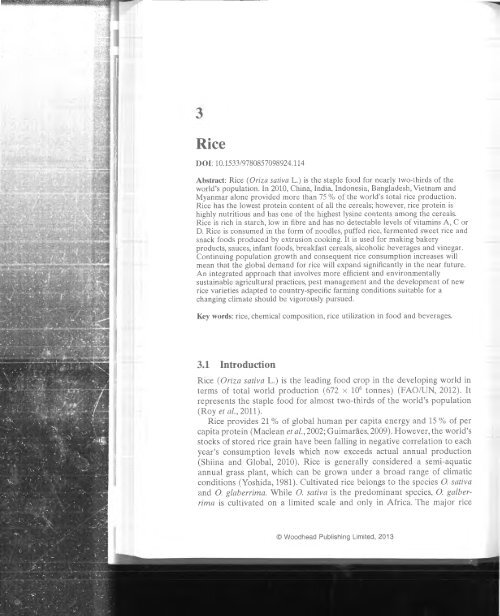Arendt und Zannini - 2013 - Cereal grains for the food and beverage industries
Arendt und Zannini - 2013 - Cereal grains for the food and beverage industries
Arendt und Zannini - 2013 - Cereal grains for the food and beverage industries
Create successful ePaper yourself
Turn your PDF publications into a flip-book with our unique Google optimized e-Paper software.
iSi-. , v- - ■^ »--•i-<br />
%iá»S«á^Táfe¿«*tóaá<br />
5-|S^<br />
Rice<br />
DOI; 10.1533/9780857098924.114<br />
Abstract: Rice (Oriza sativa L.) is <strong>the</strong> staple <strong>food</strong> <strong>for</strong> nearly two-thirds of <strong>the</strong><br />
world’s population. In 2010, China, India, Indonesia, Bangladesh, Vietnam <strong>and</strong><br />
Myanmar alone provided more than 75 % of <strong>the</strong> world’s total rice production.<br />
Rice has <strong>the</strong> lowest protein content of all <strong>the</strong> cereals; however, rice protein is<br />
highly nutritious <strong>and</strong> has one of <strong>the</strong> highest lysine contents among <strong>the</strong> cereals.<br />
Rice is rich in starch, low in fibre <strong>and</strong> has no detectable levels of vitamins A, C or<br />
D. Rice is consumed in <strong>the</strong> <strong>for</strong>m of noodles, puffed rice, fermented sweet rice <strong>and</strong><br />
snack <strong>food</strong>s produced by extrusion cooking. It is used <strong>for</strong> making bakery<br />
products, sauces, infant <strong>food</strong>s, breakfast cereals, alcoholic <strong>beverage</strong>s <strong>and</strong> vinegar.<br />
Continuing population growth <strong>and</strong> consequent rice consumption increases will<br />
mean that <strong>the</strong> global dem<strong>and</strong> <strong>for</strong> rice will exp<strong>and</strong> significantly in <strong>the</strong> near future.<br />
An integrated approach that involves more efficient <strong>and</strong> environmentally<br />
sustainable agricultural practices, pest management <strong>and</strong> <strong>the</strong> development of new<br />
rice varieties adapted to country-specific farming conditions suitable <strong>for</strong> a<br />
changing climate should be vigorously pursued.<br />
Key words: rice, chemical composition, rice utilization in <strong>food</strong> <strong>and</strong> <strong>beverage</strong>s.<br />
3.1 Introduction<br />
Rice {Oriza sativa L.) is <strong>the</strong> leading <strong>food</strong> crop in <strong>the</strong> developing world in<br />
terms of total world production (672 x 10® tonnes) (FAO/UN, 2012). It<br />
represents <strong>the</strong> staple <strong>food</strong> <strong>for</strong> almost two-thirds of <strong>the</strong> world’s population<br />
(Roy et al., 2011).<br />
Rice provides 21 % of global human per capita energy <strong>and</strong> 15 % of per<br />
capita protein (Maclean et a/., 2002; Guimaraes, 2009). However, <strong>the</strong> world’s<br />
stocks of stored rice grain have been falling in negative correlation to each<br />
year’s consumption levels which now exceeds actual annual production<br />
(Shiina <strong>and</strong> Global, 2010). Rice is generally considered a semi-aquatic<br />
annual grass plant, which can be grown <strong>und</strong>er a broad range of climatic<br />
conditions (Yoshida, 1981). Cultivated rice belongs to <strong>the</strong> species O. sativa<br />
<strong>and</strong> O. glaberrima. While O. sativa is <strong>the</strong> predominant species, O. gaitérrima<br />
is cultivated on a limited scale <strong>and</strong> only in Africa. The major rice<br />
© Woodhead Publishing Limited, <strong>2013</strong>

















